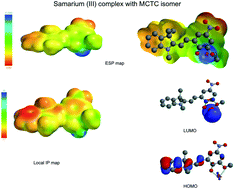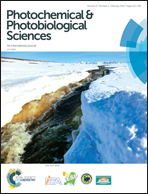Lanthanide complexes of spiropyran photoswitch and sensor: spectroscopic investigations and computational modelling
Abstract
A number of novel lanthanide (Gd3+, Sm3+, and Tb3+) complexes of the 1′,3′-dihydro-8-methoxy-1′,3′,3′-trimethyl-6-nitrospiro[2H-1-benzopyran-2,2′-(2H)-indole] (spiropyran; SP), a widely studied molecular photoswitch, were investigated. Comparative spectroscopic (absorption and fluorescence) and kinetic investigations of the stimulated photochromic and solvatochromic behavior were carried out in different media. SP embedded in a rigid thin film of poly(methylmethacrylate) might be exploited profitably as an optical sensor for the identification of a solvent's nature. Furthermore, thermodynamic parameters, in particular, Gibbs’ free energy change (ΔG°), were derived using density functional theory quantum chemical calculations with the SP and merocyanine coloured form. The model used was the B3LYP/6-31G(d,p)/SCRF = (SMD, solvent) and its time-dependent extension procedure was used to quantitatively explain the structural isomerization in response to a variety of stimuli, such as light, solvent nature, lanthanide(III) ions, and macromolecular support. These findings might be useful for the design of photoswitchable and energy transfer materials and their related fields.



 Please wait while we load your content...
Please wait while we load your content...